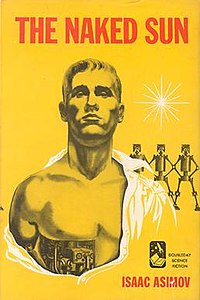The Naked Sun
by Isaac Asimov
The story arises from the murder of Rikaine Delmarre, a prominent "fetologist" (fetal scientist), responsible for the operation of the planetary birthing center of Solaria, a planet politically hostile to Earth, whose death Elijah Baley is called to investigate, at the request of the Solarian government. He is again partnered with the humanoid robot R. Daneel Olivaw, and asked by Earth's government to assess the Solarian society for weaknesses.
The book focuses on the unusual traditions, customs, and culture of Solarian society. The planet has a rigidly controlled population of 20,000, and all work is done by robots, which outnumber humans ten thousand to one. People are taught from birth to avoid personal contact, and live on huge estates, either alone or with their spouse only. Face-to-face interaction (referred to in the book as "seeing"), and especially impregnating a woman, when replacement of a descendent is necessary, was seen as a dirty chore. (Other science fiction novels examine the extra-uterine care of fetuses, but this is not Asimov's concern here.) Communication takes place through technology unknown off of their world: holography, electron microscopes then being developed, and from which holography descends.
The Solarians have no modesty when communicating with each other in this fashion. In the book it is referred to as "viewing", in contrast to "seeing", which is face-to-face and dangerous, because a disease could be transmitted. Nudity was frequent.
Baley, however, insists on face-to-face conversations, traveling in a closed vehicle because of his own agoraphobia, resulting from his life in the enclosed cities of Earth.
Normally the prime suspect in a murder would have been Delmarre's wife Gladia, who was present in the house when he was killed by being beaten over the head. She claims to have no memory of what happened, nor is there any sign of the object used to beat Rikaine Delmarre to death. The only witness is a malfunctioning house robot that has suffered damage to its positronic brain because it allowed harm to be done to a human, in violation of the First Law.
Baley's first encounter with Gladia is through viewing, at which point he discovers that Solarians have no taboo about nudity when viewing, though Baley is shocked. Thereafter he develops a relationship with Gladia in face-to-face contact. She reveals to Baley that she does not like all Solarian customs, and was on bad terms with Rikaine, partly from sexual frustration.
The situation becomes more complex when Hannis Gruer, the Head of Security on Solaria, is poisoned while viewing with Baley. Baley, unable to intervene physically, has to call on Gruer's robots to save him. Baley is able to prevent the house robots from cleaning up the scene and destroying evidence, which happened after Delmarre's death.
Ultimately, it is revealed that Delmarre's neighbor, roboticist Jothan Leebig, was working on putting positronic brains in spaceships. This would negate the First Law, as such ships would not recognize humans, and would be able to attack and destroy other ships without regard for their crews. Delmarre was one of his opponents, as were other Solarians who were horrified by the prospect of robots that could actually harm them. Leebig poisoned Gruer by tricking his robots, using his knowledge of positronic brains, into putting poison into Gruer's drink. Daneel goes to arrest Leebig, who kills himself in Solarian fear of human contact, not knowing that Daneel is a robot. It is assumed that he also engineered the murder of Rikaine Delmarre. Baley conceals Gladia's role on the grounds that her emotional breakdown was under the pressure of the Solarian way of life. Leebig had instructed the Delmarre house robots to detach an arm and give it to Gladia in the heat of an argument. She then hit her husband with it, killing him, before going into a fugue state, after which she remembered nothing. She decides to emigrate to the Spacer planet of Aurora.
Baley returns to Earth to acclaim from his boss. Asked by his boss to reveal any weaknesses he found, Baley says that the features once regarded as Spacer strengths; their robots and long lives, will ultimately prove to be weaknesses. They discourage an active, exploratory attitude that Earth-born humans will eventually rediscover once they are able to leave Earth.
The story of the aftereffects can be found in the sequel The Robots of Dawn.
